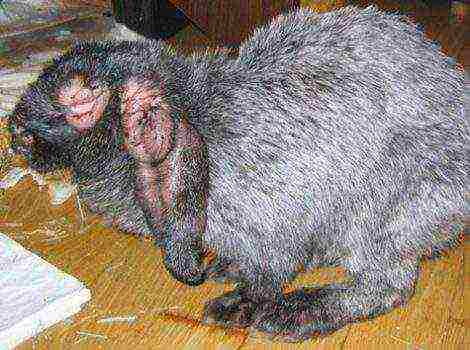Content [show]
How to feed little rabbits correctly
It is not difficult to feed rabbits and get a healthy livestock if you work hard enough. After birth, babies in the first weeks of life receive full nutrition with rabbit milk. Then they switch to complementary foods. There are some differences in the diet for babies and adults. Correctly selected food will improve the quality of fur and meat, and for this you need to know how to properly feed young of different ages. In this article, you will learn how to feed young rabbits, as well as consider all the nuances of artificial feeding.
How to feed the rabbit from the moment of birth to complementary feeding
From birth to rabbit feeding, mother's milk serves as their main food. When the rabbit is behaving normally and she is healthy, then there is no reason to worry. At that time the care of the breeder to provide them with good conditions... This is abundance in quality food and water. At this time, the female is experiencing a great load on the body, so you should increase nutrients in the diet... She produces 170 grams of milk per day, or even more. And with it 25 grams of protein. Therefore, she needs more nutritious feed for replenishment than before the lactation period. For a rabbit with an average weight of 5-6 kg, the consumption rate of feed units is 330-700 grams (1 feed unit is equivalent to 1 kg of oats). The menu should be changed every week.
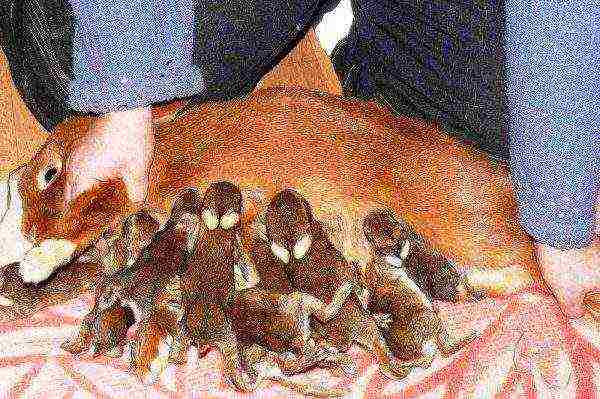
At this time, the rabbit should be fed:
- in summer: clover, alfalfa, oat mixture, herbs;
- in winter: bean hay, boiled potatoes, silage, carrots.
Also on the menu add a mixture of peas, oats, bran and cake.
How much feed is needed for a rabbit per day
- from hay 100-300 grams;
- sunflower cake 40-60 grams;
- sunflower grotto 30 grams;
- feed yeast 5 grams;
- fish oil 4 grams;
- meat and bone meal 7 grams;
- bone meal 4 grams;
- chalk - 3 grams;
- table salt 2 grams.
During the feeding period for the female, it is better to make feed mixtures,%:
Recipe 1:
- oats - 60;
- alfalfa - 30-40;
- mineral supplements.

Recipe 2:
- from bran - 12;
- corn - 10;
- alfalfa - 10;
- mineral additives -2.
The rabbit should be given from 20 to 500 grams of feed mixture per day... On day 20, the amount of food is increased, because the babies begin to eat with the mother.
To increase lactation during this period, you can pour some milk in addition to water... 0.5 l in the morning and 0.5 l in the evening. To train her, use a 5 gram syringe. Pour a little into your mouth and then offer it to her in a bowl. Be careful with milk in the summer so as not to make it sour. Otherwise, there may be problems with the intestines. Cow's or goat's milk, can be replaced with dry or mixtures.
How to feed rabbits without a rabbit at home
Sometimes there are cases that newborn rabbits are left without rabbit milk. How to get out of this situation? In this position, they can be fed artificially, even at home.
Up to 7 days
Babies up to 7 days of age you can feed it with cow, goat milk or use dry milk mixtures.Cow's milk is diluted 1: 1 with condensed unsweetened milk, the milk mixture is made at double concentration, and goat's milk is given in pure form. Introduce milk with a syringe or make a nipple. We wash the penicillin bottle and put a nipple on it. We make a nipple from a pipette rubber cap.
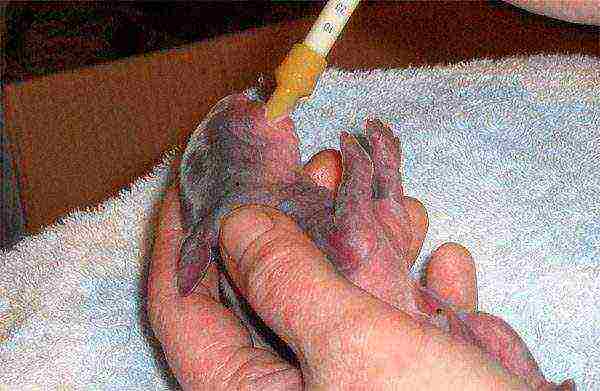
You need to feed the rabbit 3 to 5 times a day.
- once in the early morning;
- 3 times during the day;
- once in the evening.
One feeding leaves about 1 ml.
After 7 days
Up to one week of age only milk food. After 7 days of age increase the amount of food by half, and the feeding is reduced to 3 times a day. By 15 days the portions are tripled.
In the early days of the baby, it is difficult to feed, so take a cotton swab, moisten it and gently wipe the mouth with it. Wait for him to lick and continue on. When the bunny gets used to it, switch to a syringe or pacifier.
From 20 days to a month
Rabbits from 20 days of age can already drink milk from a bowl on their own... We adhere to the milk menu until the age of one month. After that, you can give them in small quantities high-quality hay, grated carrots and moistened feed. Mixed mixed fodder should be given in small portions, avoiding souring. You can buy herbal pellets for feeding rabbits at the veterinary pharmacy. How much feed to feed the bunny? The portion is calculated by the weight of the baby and should be 3% of the mass.
Months of age and older
From the moment the milk decreases, they need to be additionally given water. First, we force to drink water with the help of a nipple. Later, when they start drinking on their own, water should be in the bowl at all times. Lack of water threatens rabbits with kidney disease... Until the age of 45 days, milk feeding and a smooth transition to an adult diet are possible.
Some tips for artificial feeding of newborn rabbits with milk
If such a misfortune happened and the babies were left without maternal care and milk, then rabbit can be fed artificially... Although this process is troublesome and requires a lot of patience. And the result is not 100%, but rather deplorable, but you need to try. Such rabbits are usually lagging behind in development.
With such feeding keep clean... All nipples and utensils should be scalded with boiling water. Since the babies are naked, they should be kept warm. You can put a heating pad in the box where they are contained. When they are overgrown with fur, it can be removed.
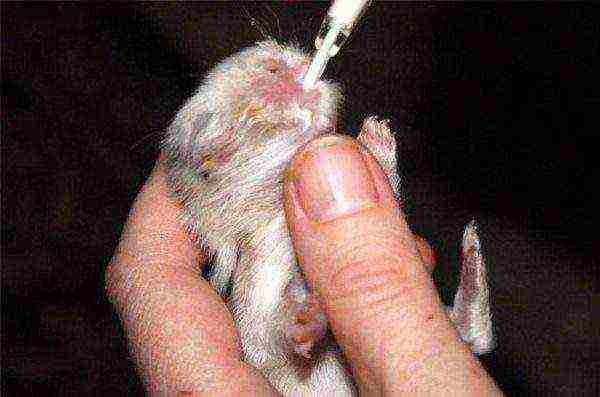
It's better to feed goat milk, but if this is not the case, then in the veterinary pharmacy you can buy powdered milk or mixtures for fattening puppies.
You need to feed often enough. They should eat 5 times a day in small portions.... Help your baby to empty before feeding. Under natural conditions, the mother does this, but in this case you need to do it yourself.
With a damp cotton pad, massage movements, wipe the body... We start to massage the tummy. Pressing slightly, we carry out several times from the navel to the tail. We carry out this procedure until the baby is empty. Then we wipe the anus and feed the rabbit. Do the emptying massage for 2 weeks. Then it will empty itself on its own.
If it has not been emptied, then it lacks nutrition. You need to add a little milk. A well-fed baby behaves calmly. Doesn't bounce in sleep. Does not crawl over the box. The tummy is plump and elastic.
By 15 days, a place in the box should be allocated where it will be dark... Rabbits by this time like to sleep in a dark place.Cover one corner with a rag.
If the feeding process is successful, then by day 20, the rabbit can drink milk from a saucer... You can also give him finely chopped carrots. Green, high-quality hay or dried grass. If this happens in winter, then the greens can be grown hydroponically. Babies can also be given hay flour.... Gradually, you should add moistened compound feed to the diet in small portions. Boiled thick porridge.
As already stated, cleanliness must be maintained. The feed must be fresh... No souring, no mildew. Prepare the mixture just before feeding. Vegetables must be washed.
Perhaps these tips will help you feed a healthy baby.
How to feed small rabbits after jigging from their mother, how to make food
The deposition of rabbits from the mother takes place at different ages from 28 to 45 days... But it is best to do this at 45 days of age. Jigging at this time reduces the mortality of the young. Since by this time his digestive system is being formed. Together with his mother, he feeds on hay and the rest of the food from the adult diet.
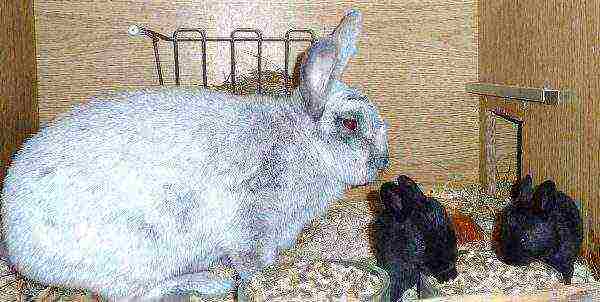
In the beginning, they are given the same food that they ate with their mother. New feed for rabbits is introduced gradually in small portions. It is recommended to drip vitamin B into the water... 1 liter requires 50 ml. It prevents stress.
The rabbit's diet should contain:
- dried greens or quality hay;
- boiled potato;
- pumpkin;
- zucchini;
- powdered milk;
- vitamin preparationsif it's winter;
- hay flour;
- grated or cut into pieces carrot;
- oats;
- moisturized compound feed;
- rolled grain;
- bone flour;
- fish flour.
- return
During this period, it is useful to feed:
- chicory;
- yarrow;
- chamomile;
- St. John's wort;
- Dubrovnik;
- burdocks;
- tree branches with leaves.

The baby rabbit should receive:
45-60 days:
- 70-125 feed units;
61-90 days:
- 145-170 c.u .;
90-120 days:
- 170-225 c.u .;
Since the rabbit has intensive growth during this period, the digestible protein should be 18 grams per 100 c.u. Grown-up rabbit from 4 months are transferred to an adult diet.
When distributing hay, be careful not to be hit toxic herbs:
- dope;
- henbane; and many others.
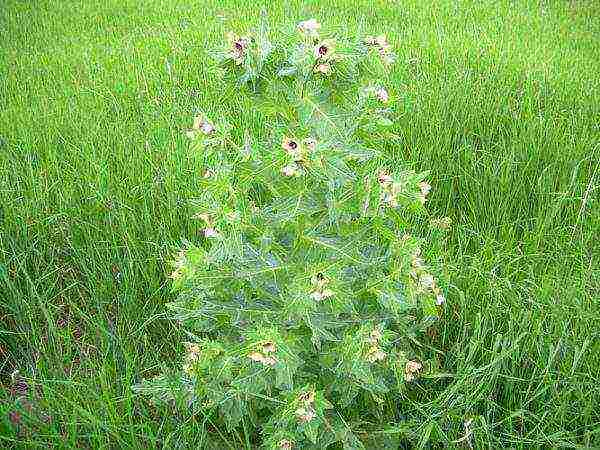
For grown-up crawls from 4 months of age, the feed ration is changed... Reduce the share of compound feed. It contains a lot of fat, which in large quantities is harmful to animals. Give plenty of vitamin hay, green grass and vegetables.
Winter feeding,%
- hay 10-20;
- compound feed 55-65;
- juicy feed 20-30.
Summer feeding,%
- green grass 30-40;
- concentrate 60-70.
Feed is distributed 3-4 times a day... At the same time, if some food remains from the previous feeding, then its rate should be slightly reduced. Do not let the mash sour. Such feed must be removed. Fresh grass should be dried before feeding... Remove dirt from vegetables and cut into pieces.
The feed in the feeders should be constantly. The digestive system in rabbits is designed so that in order for it to empty, food must push food. therefore hay should be constant... Even a little hunger can lead to problems.
It is important for the breeder to raise healthy offspring of the rabbit. After all, these are females in the future, bringing offspring, and therefore a good income. To keep the rabbits healthy, they you need to provide proper nutrition and conditions of detention.

